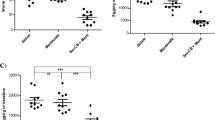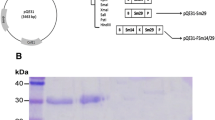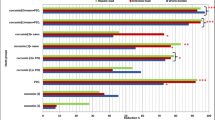Abstract
Schistosomiasis is one of the most common causes of morbidity and mortality from parasitic diseases. Mass treatment has proven to be insufficient because of repeated infection after treatment and the appearance of strains resistant to drug therapy. Hence, immunization is a new approach to control the disease and limit the pathological consequences of schistosomiasis. To evaluate the prophylactic effect of Cercarial antigen (CAP) loaded on chitosan nanoparticles (CSNPs) as a potential vaccine against Schistosoma mansoni-infected mice. 130 mice divided into 2 groups were used: Group I: Control groups (50 mice) subdivided into subgroup Ia (10 mice): Non-infected mice (normal control), subgroup Ib (20 mice): Schistosoma infected mice (infected control) and subgroup Ic (20 mice): Non-infected mice receiving NPs only. Group II: Vaccinated group (80 mice) subdivided equally into subgroup IIa (CAP): Received cercarial antigen and subgroup IIb (CAP + CSNP): Received cercarial antigen loaded on chitosan NPs then both vaccinated groups were infected with S. mansoni 3 weeks following the initial vaccination dose. CAP + CSNP and CAP groups showed significant reduction in adult worms count, hepatic egg count, hepatic granulomas number and size in comparison to the infected control group. Elevation of serum IgG and IgM levels, CD4+ and CD8+ T cell frequencies, IL-4, IL-10 and INF-γ levels was more significant in CAP + CSNP group than CAP group. CAP + CSNP is a promising new preparation of Schistosomal antigens that gave better results than immunization with CAP alone. CSNPs enhanced the immune and protective effect of CAP as validated by parasitological, histopathological and immunohistochemical studies.









Similar content being viewed by others
Availability of data and materials
The authors confirm that the data supporting the findings in this study are available within the article and its supplementary material. Raw data that support the findings of this study are available from the corresponding author, upon reasonable request.
References
Abdel-Hakeem SS, Abdel-Samiee MA, Abed GH (2020) An insight into the potential parasitological effect of Schistosoma mansoni antigens in infected mice: prophylactic role of cercarial antigen. Microsc Microanal 26(4):708–716
Ahmad G, Zhang W, Torben W, Ahrorov A, Damian RT, Wolf RF et al (2011) Preclinical prophylactic efficacy testing of Sm-p80-based vaccine in a nonhuman primate model of Schistosoma mansoni infection and immunoglobulin G and E responses to Sm-p80 in human serum samples from an area where schistosomiasis is endemic. J Infect Dis 204:1437–1449
Ahmad G, Zhang W, Torben W, Haskins C, Diggs S, Noor Z et al (2009) Prime-boost and recombinant protein vaccination strategies using Sm-p80 protects against Schistosoma mansoni infection in the mouse model to levels previously attainable only by the irradiated cercarial vaccine. Parasitol Res 105:1767–1777
Alves CC, Araujo N, Bernardes WPOS, Mendes MM, Oliveira SC, Fonseca CT (2018) A strong humoral immune response induced by a vaccine formulation containing rSm29 adsorbed to Alum is associated with protection against Schistosoma mansoni reinfection in mice. Front Immunol 9:1–12
Aly NSM, Kim HS, Eraky MA, Kholy AAE, Ali BT, Miyoshi SI et al (2023) Evaluation of schistosomula lung antigen preparation and soluble egg antigen vaccines on experimental schistosomiasis mansoni. Parasites Hosts Dis 61(3):251–262
Assis NR, Caires AJ, Figueiredo BC, Morais SB, Mambelli FS, Marinho FV et al (2018) The use of gold nanorods as a new vaccine platform against schistosomiasis. J Control Release 275:40–52
Bancroft JD, Stevens A (1975) Histopathological stains and their diagnostic uses. Churchill Livingstone, New York, pp 1–20
Bancroft JD, Stevens A (2008) Theory and practice of histological techniques. Churchill Livingstone, New York, pp 119–138
Booth M, Mwatha JK, Joseph S, Jones FM, Kadzo H, Ireri E et al (2004) Periportal fibrosis in human Schistosoma mansoni infection is associated with low IL-10, low IFN-gamma, high TNF-alpha, or low RANTES, depending on age and gender. J Immunol 172(2):1295–1303
Bozkir A, Saka OM (2004) Chitosan nanoparticles for plasmid DNA delivery: effect of chitosan molecular structure on formulation and release characteristics. Drug Deliv 11(2):107–112
Bradford MM (1976) A rapid and sensitive method for the quantitation of microgram quantities of protein utilizing the principle of protein-dye binding. Anal Biochem 72:248–254
Buddenborg SK, Lu Z, Sankaranarayan G, Doyle SR, Berriman M (2023) The stage- and sex-specific transcriptome of the human parasite Schistosoma mansoni. Sci Data 10:775
Burke ML, Jones MK, Gobert GN, Li YS, Ellis MK, McManus DP (2009) Immunopathogenesis of human schistosomiasis. Parasite Immunol 31(4):163–176
Caldas IR, Campi-Azevedo AC, Oliveira LF, Silveira AM, Oliveira RC, Gazzinelli G (2008) Human schistosomiasis mansoni: immune responses during acute and chronic phases of the infection. Acta Trop 108(2–3):109–117
Campbell SJ, Biritwum NK, Woods G, Velleman Y, Fleming F, Stothard JR (2018) Tailoring water, sanitation, and hygiene (WASH) targets for soil-transmitted Helminthiasis and Schistosomiasis control. Trends Parasitol 34(1):53–63
Cheever AW (1968) Conditions affecting the accuracy of potassium hydroxide digestion in techniques for counting Schistosoma mansoni eggs in tissues. Bull World Health Organ 39:328–331
Cioli D, Pica-Mattoccia L, Basso A, Guidi A (2014) Schistosomiasis control: praziquantel forever? Mol Biochem Parasitol 195(1):23–29
Cosenza M, Barrios E, Felibertt P, Castillo-Corujo A, Ochoa G, Velasquez E et al (2017) IgM and IgG responses in Schistosoma mansoni-infected mice using egg and worm antigens: does response vary with parasitic burden and phase of infection? Exp Parasitol 179:36–42
Danesh-Bahreini MA, Shokri J, Samiei A, Kamali-Sarvestani E, Barzegar Jalali M, Mohammadi-Samani S (2011) Nanovaccine for leishmaniasis: preparation of chitosan nanoparticles containing Leishmania superoxide dismutase and evaluation of its immunogenicity in BALB/c mice. Int J Nanomed 6:835–842
Date AA, Joshi MD, Patravale VB (2007) Parasitic diseases: liposomes and polymeric nanoparticles versus lipid nanoparticles. Adv Drug Deliv Rev 56(1):505–521
De Melo TT, Araujo JM, De Sena IC, Alves CC, Araujo N, Fonseca CT (2013) Evaluation of the protective immune response induced in mice by immunization with Schistosoma mansoni schistosomula tegument (Smteg) in association with CpG-ODN. Microbes Infect 15(1):28–36
El Sayed NM, Fathy GM, Abdel-Rahman SA, El-Shafei MA (2016) Cytokine patterns in experimental schistosomiasis mansoni infected mice treated with silymarin. J Parasit Dis 40(3):922–929
Elmi T, Gholami S, Fakhar M, Azizi F (2013) A review on the use of nanoparticles in the treatment. J Mazandaran Univ Med Sci 23(102):126–133
Elsenoor KJ, Kuijk LM, Lindhorst TK, Cummings RD, van Die I (2015) Schistosoma mansoni soluble egg antigens induce expression of the negative regulators SOCS1 and SHP1 in human dendritic cells via interaction with the mannose receptor. PLoS ONE 10(4):1–17
Etewa S, Al-Hoot AA, Sharaf H, Moawad H, Mohamed S, Alshafey M et al (2019) Modelling approaches to predict and evaluate schistosomiasis immunization utilizing SEA loaded on chitosan nanoparticles via liver tissue differentiation and angiogenesis. Parasitol United J 12(3):197–208
Etewa S, Al-Hoot AA, Sharaf H, Mohammad S, Moawad H, Sarhan M, Senosy H (2018) A potential prophylactic strategy of anti-schistosomal immunization using nanotechnology in murine models. Parasitol United J 11(3):162–174
Eyayu T, Zeleke AJ, Worku L (2020) Current status and future prospects of protein vaccine candidates against Schistosoma mansoni infection. Parasite Epidemiol Control 11:1–10
Gregory AE, Williamson ED, Prior JL, Butcher WA, Thompson IJ, Shaw AM et al (2012) Conjugation of Y. pestis F1-antigen to gold nanoparticles improves immunogenicity. Vaccine 30(48):6777–6782
Hacariz O, Sayers G, McCullough M, Garrett M, O’Donovan J, Mulcahy G (2009) The effect of Quil adjuvant on the course of experimental Fasciola hepatica infection in sheep. Vaccine 27:45–50
Hoffmann KF, Wynn TA, Dunne DW (2002) Cytokine mediated host responses during schistosome infections: walking the fine line between immunological control and immunopathology. Adv Parasitol 52:265–307
Hotez PJ, Bottazzi ME (2023) Human schistosomiasis vaccines as next generation control tools. Trop Med Infect Dis 8(3):170
Inobaya MT, Olveda RM, Chau TN, Olveda DU, Ross AG (2014) Prevention and control of schistosomiasis: a current perspective. Res Rep Trop Med 5:65–75
Jacobs W, Bogers J, Deelder A, Wery M, Marck E (1997) Adult Schistosoma mansoni worms positively modulate soluble egg antigen induced inflammatory hepatic granuloma formation in vivo. Serological analysis and immunophenotyping of extracellular matrix proteins, adhesion molecules and chemokines. Am J Pathol 150(6):2033–3045
Jarudilokkul S, Tongthammachat A, Boonamnuayvittaya V (2011) Preparation of chitosan nanoparticles for encapsulation and release of protein. Korean J Chem Eng 28(5):1247–1251
Kim KH (2009) Effects of chitosan on the production of Th1 and Th2 cytokines in mice. J Life Sci 19:411–416
Koppolu B, Zaharoff DA (2013) The effect of antigen encapsulation in chitosan particles on uptake, activation and presentation by antigen presenting cells. Biomater 34(9):2359–2369
Kupferschmidt K (2013) A worm vaccine: coming at a snail’s pace. Science 339:502–503
Légaré D, Ouellette M (2017) Drug resistance assays for parasitic diseases. Antimicrobial drug resistance. Springer, Cham, pp 1409–1463
Li XH, Xu YX, Vance G, Wang Y, Lv LB, van Dam GJ et al (2015) Evidence that Rhesus macaques self-cure from a Schistosoma japonicum infection by disrupting worm esophageal function: a new route to an effective vaccine? PLoS Negl Trop Dis 9:1–26
Lochmatter C, Schneider CL, Ingram K, Keiser J, Schifferli JA (2012) Schistosoma mansoni tetraspanning orphan receptor (SmTOR): a new vaccine candidate against schistosomiasis. Clin Exp Immunol 170(3):342–357
Mansouri S, Lavigne P, Corsi K, Benderdour M, Beaumont E, Fernandes JC (2004) Chitosan-DNA nanoparticles as non-viral vectors in gene therapy: strategies to improve transfection efficacy. Eur J Pharm Biopharm 57(1):1–8
Mata E, Igartua M, Patarroyo M, Pedraz J, Hernánde R (2011) Enhancing immunogenicity to PLGA microparticulate systems by incorporation of alginate and RGD-modified alginate. Eur J Pharm Sci 44:32–40
McManus DP, Loukas A (2008) Current status of vaccines for schistosomiasis. Clin Microbiol Rev 21(1):225–242
Means TK, Hayashi F, Smith KD, Aderem A, Luster AD (2003) The Toll-like receptor 5 stimulus bacterial flagellin induces maturation and chemokine production in human dendritic cells. J Immunol 170:5165–5175
Merrifield M, Hotez PJ, Beaumier CM, Gillespie P, Strych U, Hayward T et al (2016) Advancing a vaccine to prevent human schistosomiasis. Vaccine 34(26):2988–2991
Mohammed MA, Syeda JTM, Wasan KM, Wasan EK (2017) An overview of Chitosan nanoparticles and its application in non-parenteral drug delivery. Pharm 9(4):1–26
Morais CN, Souza JR, Melo WG, Aroucha ML, Miranda P, Domingues AL et al (2008) Cytokine profile associated with chronic and acute human schistosomiasis mansoni. Mem Inst Oswaldo Cruz 103(6):561–568
Moser D, Tendler M, Griffiths G, Klinkert MQ (1991) A 14-kDa Schistosoma mansoni polypeptide is homologous to a gene family of fatty acid binding proteins. J Biol Chem 266(13):8447–8854
Mudgal J, Mudgal PP, Kinra M, Raval R (2019) Immunomodulatory role of chitosan-based nanoparticles and oligosaccharides in cyclophosphamide-treated mice. Scand J Immunol 89(4):1–8
Nabih I, Soliman AM (1986) Studies on fresh water snails, specific intermediate host for schistosomiasis. II. Isolation of total protein from native and irradiated snails. Cell Mol Biol 32:315–317
Ngai P, McCormick S, Small C, Zhang X, Zganiacz A, Aoki N et al (2007) Gamma interferon responses of CD4 and CD8 T-cell subsets are quantitatively different and independent of each other during pulmonary Mycobacterium bovis BCG infection. Infect Immun 75(5):2244–2252
Ochoa G, Mujica A, Barrios EE, Cosenza M, Capellán R, Ayala J et al (2015) Respuesta humoral IgM e IgG frente a antigenos de excreción-secreción de Schistosoma mansoni en murinos infectados y su relación con las citoquinas Il-10 y TNF-α. Kasmera 43(2):98–111
Oliveira CR, Rezende CM, Silva MR, Borges OM, Pêgo AP and Goes AM (2012a) Oral vaccination based on DNA-chitosan nanoparticles against Schistosoma mansoni infection. Sci World J, 2012:1–11
Oliveira CR, Rezende CM, Silva MR, Pêgo AP, Borges O, Goes AM (2012b) A new strategy based on SmRho protein loaded chitosan nanoparticles as a candidate oral vaccine against schistosomiasis. PLoS Negl Trop Dis 6(11):1–13
Pearson MS, Pickering DA, McSorley HJ, Bethony JM, Tribolet L, Dougall AM et al (2012) Enhanced protective efficacy of a chimeric form of the schistosomiasis vaccine antigen Sm-TSP-2. PLoS Negl Trop Dis 6(3):1–10
Peter PA, Warren KS (1969) A rapid method of infecting mice and other laboratory animals with Schistosoma mansoni: subcutaneous injection. J Parasitol 55(3):558
Powers J, Nash P, Rhyan J, Yoder CA, Miller LA (2007) Comparison of immune and adverse effects induced by AdjuVac and Freund’s complete adjuvant in New Zealand white rabbits (Oryctolagus cuniculus). Lab Anim 36:51–58
Prego C, Paolicelli P, Díaz B, Vicente S, Sánchez A, González- Fernández Á et al (2010) Chitosan-based nanoparticles for improving immunization against hepatitis B infection. Vaccine 28:2607–2614
Pusic K, Aguilar Z, McLoughlin J, Kobuch S, Xu H, Tsang M et al (2013) Iron oxide nanoparticles as a clinically acceptable delivery platform for a recombinant blood-stage human malaria vaccine. FASEB J 27:1153–1166
Quadir MA, Morton SW, Mensah LB, Shopsowitz K, Dobbelaar J, Effenberger N et al (2017) Ligand-decorated click polypeptide derived nanoparticles for targeted drug delivery applications. Nanomed 13(5):1797–1808
Ranasinghe SL, Duke M, Harvie M, McManus DP (2018) Kunitz-type protease inhibitor as a vaccine candidate against schistosomiasis mansoni. Int J Infect Dis 66:26–32
Rico LG, Juncà J, Ward MD, Bradford JA, Petriz J (2019) Flow cytometric significance of cellular alkaline phosphatase activity in acute myeloid leukemia. Oncotarget 10(65):6969–6980
Santini-Oliveira M, Machado Pinto P, Santos Td, Vilar MM, Grinsztejn B, Veloso V et al (2022) Development of the Sm14/GLA-SE schistosomiasis vaccine candidate: an open, non-placebo-controlled, standardized-dose immunization phase Ib clinical trial targeting healthy young women. Vaccines 10(10):1724
Schwartz C, Oeser K, Prazeres Da Costa C, Layland LE, Voehringer D (2014) T cell derived IL-4/IL-13 protects mice against fatal Schistosoma mansoni infection independently of basophils. J Immunol 193:3590–3599
Shaheen S, Arafah MM, Alshanwani AR, Fadda LM, Alhusaini AM, Ali HM et al (2021) Chitosan nanoparticles as a promising candidate for liver injury induced by 2-nitropropane: implications of P53, iNOS, VEGF, PCNA, and CD68 pathways. Sci Prog 104(2):1–19
Shvedova AA, Kisin ER, Mercer R, Murray AR, Johnson VJ, Potapovich AI et al (2005) Unusual inflammatory and fibrogenic pulmonary responses to single walled carbon nanotubes in mice. Am J Physiol Cell Physiol 289(5):698–708
Singla AAK, Chawla M (2001) Chitosan: some pharmaceutical and biological aspects: an update. J Pharm Pharmacol 53(8):1047–1067
Smith DM, Simon JK, Baker JR (2013) Applications of nanotechnology for immunology. Nat Rev Immunol 13:592–605
Smithers SR, Terry RJ (1965) The infection of laboratory hosts with cercariae of Schistosoma mansoni and the recovery of the adult worms. Parasitol 55(4):695–700
Smyth D, McManus DP, Smout MJ, Laha T, Zhang W, Loukas A (2003) Isolation of cDNAs encoding secreted and transmembrane proteins from Schistosoma mansoni by a signal sequence trap method. Infect Immun 71(5):2548–2554
Soliman MF, El Shenawy NS, El Arabi SE (2008) Schistosoma mansoni: melatonin enhances efficacy of cercarial and soluble worm antigens in the induction of protective immunity against infection in the hamster. Exp Parasitol 119(2):291–295
Tebeje BM, Harvie M, You H, Loukas A, McManus DP (2016) Schistosomiasis vaccines: where do we stand? Parasit Vectors 9(1):1–15
Tedla BA, Pickering D, Becker L, Loukas A, Pearson MS (2020) Vaccination with Schistosoma mansoni cholinesterases reduces the parasite burden and egg viability in a mouse model of schistosomiasis. Vaccines 8:162
Tete SM, Wilting KR, Horst G, Klijn MA, Westra J, de Haan A et al (2013) IgG antibody and TH1 immune responses to influenza vaccination negatively correlate with M-protein burden in monoclonal gammopathy of undetermined significance. Hemat Leukemia 1(3):10–7243
Torben W, Ahmad G, Zhang W, Siddiqui AA (2011) Role of antibodies in Sm-p80-mediated protection against Schistosoma mansoni challenge infection in murine and nonhuman primate models. Vaccine 29:2262–2271
Tripathy S, Mahapatra SK, Chattopadhyay S, Das S, Dash SK, Majumder S et al (2013) A novel chitosan based antimalarial drug delivery against Plasmodium berghei infection. Acta Trop 128(3):494–503
Walter F, Winter E, Rahn S, Heidland J, Meier S, Struzek AM et al (2020) Chitosan nanoparticles as antigen vehicles to induce effective tumor specific T cell responses. PLoS ONE 15(9):1–24
WHO (2017) Schistosomiasis retrieved on June 20, 2017. http://www.who.int/mediacenter/factsheets/fs115/en/
WHO (2023) 34th meeting of the International Task Force for Disease Eradication. Weekly Epidemiol Rec 98:41–52
Wilson RA, Li XH, Castro-Borges W (2016) Do schistosome vaccine trials in mice have an intrinsic flaw that generates spurious protection data? Parasit Vectors 9:1–16
Wu GY, Halim MH (2000) Schistosomiasis: progress and problems. World J Gastroenterol 6(1):12–19
Zhang BB, Jiao YW, Cai WM, Tao J, Liu RH (2004) Influence of interferon gamma treatment on expression of TGF-beta1 and its receptors in liver fibrosis of mice with schistosomiasis japonicum. Xue Yu Ji Sheng Chong 22(6):340–343
Zolnik BS, Gonzalez-Fernandez A, Sadrieh N, Dobrovolskaia MA (2010) Nanoparticles and the immune system. Endocrinol 151:458–465
Acknowledgements
We thank the Department of Medical Parasitology, Faculty of Medicine, Tanta University, Tanta, Egypt and the Biological Unit at Theodore Bilharz Research Institute (TBRI), Imbaba, Giza, Egypt for conducting the present research.
Funding
This research did not receive any specific grant from funding agencies in the public, commercial or not-for-profit sectors.
Author information
Authors and Affiliations
Contributions
Dina A. S. Elguindy, Dalia S. Ashour, Sirria M. Elmarhoumy, Dina M. EL-Guindy and Howaida I.H. Ismail conceived and designed the study. Dina A. S. Elguindy performed the experiment while Dina M. EL-Guindy performed the histopathology study. The first draft of the manuscript was written by Dina A. S. Elguindy, and all authors commented on the previous versions of the manuscript. All authors read and approved the final manuscript.
Corresponding author
Ethics declarations
Competing interests
The authors have no relevant financial or non-financial interests to disclose.
Consent to participate and consent to publish
Not applicable
Ethical Approval
All procedures contributing to this work conform with the ethical standards of the relevant national and institutional guides on the care and the use of laboratory animals. The study was approved by the Laboratory Animal center for Research Ethics Committee of Faculty of Medicine, Tanta University, Egypt (Approval code: 34167/10/20).
Additional information
Publisher's Note
Springer Nature remains neutral with regard to jurisdictional claims in published maps and institutional affiliations.
Rights and permissions
Springer Nature or its licensor (e.g. a society or other partner) holds exclusive rights to this article under a publishing agreement with the author(s) or other rightsholder(s); author self-archiving of the accepted manuscript version of this article is solely governed by the terms of such publishing agreement and applicable law.
About this article
Cite this article
Elguindy, D.A.S., Ashour, D.S., Elmarhoumy, S.M. et al. The efficacy of cercarial antigen loaded on nanoparticles as a potential vaccine candidate in Schistosoma mansoni-infected mice. J Parasit Dis 48, 381–399 (2024). https://doi.org/10.1007/s12639-024-01677-z
Received:
Accepted:
Published:
Issue Date:
DOI: https://doi.org/10.1007/s12639-024-01677-z




